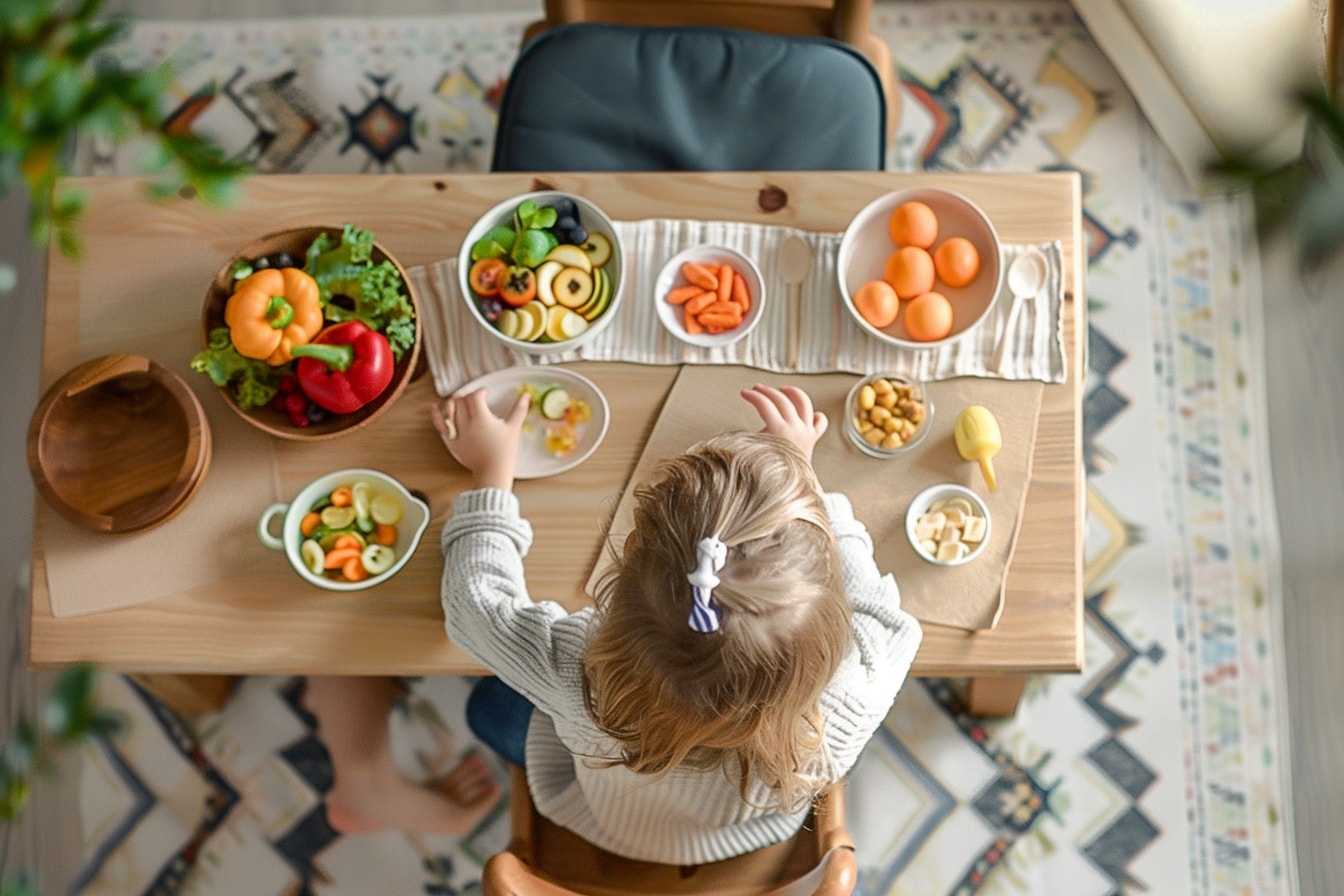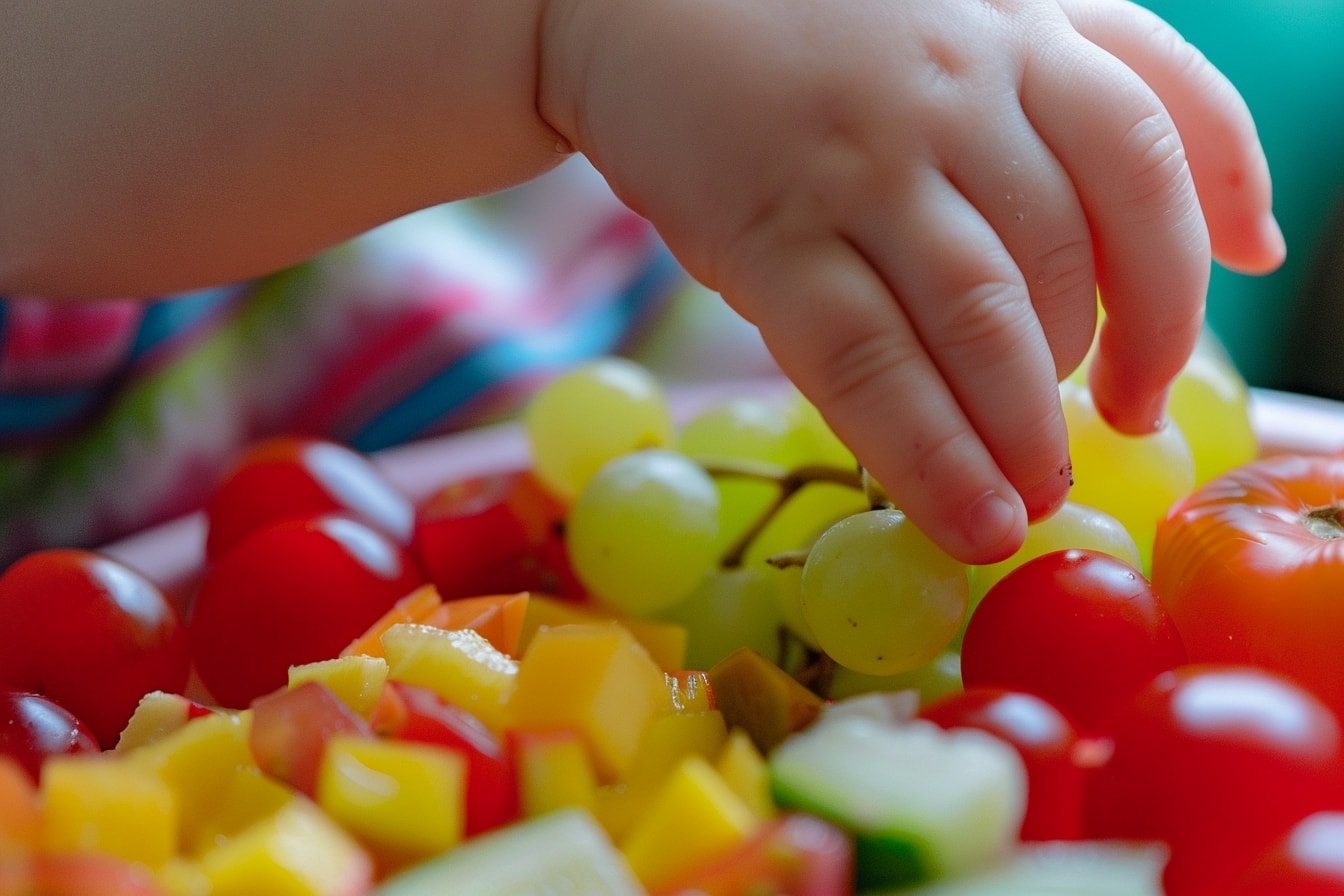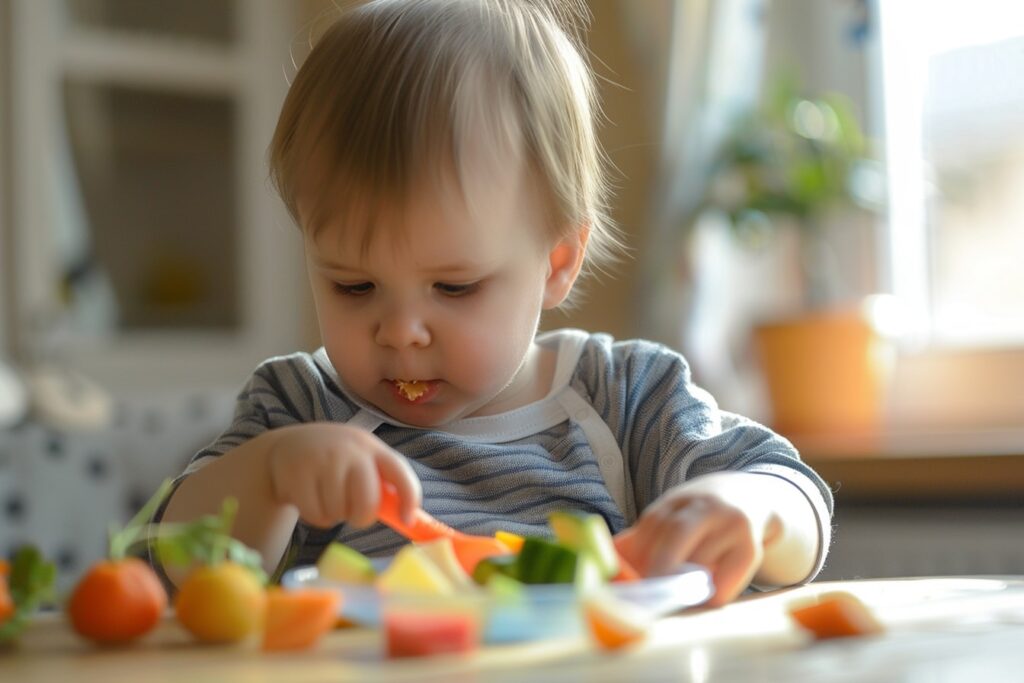Table of Contents
ToggleNourishing Independence: Introducing Solid Foods to Your Baby with Montessori Principles
As parents, we are constantly navigating the labyrinth of child-rearing, seeking out the best practices and philosophies to guide us along the way. One of the most exhilarating yet daunting milestones on this journey is introducing solid foods to our babies. It’s a moment filled with anticipation, wonder, and perhaps a touch of apprehension as we ponder the myriad of choices and approaches available.
For me, the journey of introducing solid foods to my little one was a whirlwind of emotions. I found myself standing in the baby food aisle, staring at rows of colorful jars and pouches, overwhelmed by the sheer variety and complexity of it all. I wanted more than just nourishment for my baby; I wanted to lay the groundwork for a lifetime of healthy eating habits and a positive relationship with food.
That’s when I discovered the transformative power of Montessori principles in the realm of early childhood nutrition. The Montessori approach isn’t just about education; it’s a philosophy that permeates every aspect of a child’s life, including mealtime. It’s about empowering children to explore, discover, and learn at their own pace, fostering independence and autonomy from the very beginning.
So, why Montessori? What sets this approach apart when it comes to introducing solid foods to our babies? It all boils down to one word: empowerment. Montessori principles teach us to trust in our children’s innate abilities, to create environments that support their natural curiosity and drive for independence. And when it comes to feeding our babies, this philosophy offers a refreshing perspective that prioritizes respect, mindfulness, and holistic development.
In this blog post, we’ll embark on a journey together, exploring the principles of Montessori and how they can transform the way we introduce solid foods to our babies. We’ll delve into the importance of preparation, the joy of exploration, and the art of fostering healthy eating habits from the very start. So, grab a cup of tea (or coffee, if you’re anything like me!) and let’s dive into the world of Montessori-inspired baby feeding.

Fostering Independence Through Preparation
Preparing the stage for your baby’s culinary exploration is not just about setting up a high chair and placing a spoonful of puree in front of them. It’s about creating an environment that speaks to their budding independence and innate curiosity. Montessori principles guide us to respect the child as an active participant in their own learning journey, even when it comes to something as seemingly mundane as mealtime.
First and foremost, let’s talk about the physical space. Picture this: a cozy corner of your kitchen, adorned with a child-sized table and chair, perfectly proportioned for your little one. This is their domain, their kingdom of culinary exploration. By providing furniture that is tailored to their size, we empower them to take ownership of their eating experience, fostering a sense of confidence and autonomy.
But it’s not just about the furniture; it’s about the entire atmosphere. Montessori teaches us to approach every aspect of the environment with intention and purpose. Take a moment to consider the lighting, the ambiance, even the colors and textures of the surroundings. Create a space that is calm, inviting, and free from distractions, allowing your baby to focus on the task at hand: exploring the wonderful world of solid foods.
Now, let’s talk about tools. Forget about those bulky, adult-sized utensils; it’s time to embrace the beauty of child-sized cutlery. From tiny spoons to petite bowls, these pint-sized tools are perfectly suited to your baby’s delicate grasp, empowering them to feed themselves with confidence and grace. And don’t forget about the importance of presentation. Invest in a few colorful, child-friendly dishes and cups, transforming mealtime into a sensory delight.
But perhaps the most crucial aspect of preparation lies not in the physical environment, but in the mindset of the caregiver. Montessori teaches us to approach our role with humility and respect, recognizing that our job is not to dictate or control, but to support and facilitate. So, take a step back, breathe deeply, and trust in your baby’s innate wisdom. Offer guidance when needed, but allow them the freedom to explore and discover at their own pace.
In the end, fostering independence through preparation is about creating a space where your baby feels empowered to explore, discover, and learn. It’s about setting the stage for a lifetime of healthy eating habits and a positive relationship with food. So, roll up your sleeves, gather your tools, and let’s embark on this culinary adventure together.

Encouraging Exploration and Discovery
Mealtime isn’t just about fueling our bodies; it’s a multisensory experience that engages all of our senses. For our little ones, it’s an opportunity to embark on a voyage of exploration and discovery, discovering new tastes, textures, and flavors with every bite. As parents, we have the privilege of guiding them on this journey, fostering their curiosity and nurturing their love for food.
So, how can we encourage exploration and discovery at the dinner table? It all starts with variety. Just as we wouldn’t want to eat the same thing every day, babies crave variety in their diets. Introduce them to a rainbow of fruits, vegetables, grains, and proteins, allowing them to sample a diverse array of flavors and textures. From silky avocados to crunchy carrots, each bite offers a new adventure for their taste buds.
But it’s not just about the food itself; it’s about the experience of eating. Montessori teaches us to approach mealtime with mindfulness and presence, savoring each moment and cherishing the opportunity to connect with our little ones. So, slow down, take a deep breath, and embrace the joy of shared discovery. Encourage your baby to explore their food with all of their senses, from the sight and smell of fresh produce to the sound of crunchy bites and the feel of smooth textures.
And let’s not forget about the joy of self-feeding. Montessori principles emphasize the importance of allowing children to take an active role in their own learning, and mealtime is no exception. Offer your baby finger foods and small, manageable pieces of food, allowing them to practice their fine motor skills and feed themselves with pride and independence. Sure, it may get messy (okay, it will definitely get messy!), but that’s all part of the fun.
As you embark on this culinary adventure with your little one, remember to approach each meal with an open mind and a spirit of curiosity. Celebrate their successes, laugh at their mishaps, and cherish the memories you create together around the dinner table. By embracing exploration and discovery at mealtime, you’re not just nourishing their bodies; you’re nurturing their souls and fostering a lifelong love for food.

Promoting Healthy Eating Habits
As parents, we all want what’s best for our children, especially when it comes to their health and well-being. And what could be more fundamental to their health than the food they eat? From the moment they take their first bites of solid food, we have the opportunity to shape their taste preferences, establish healthy eating habits, and lay the foundation for a lifetime of wellness.
So, how can we promote healthy eating habits in our little ones? It all starts with education. From an early age, we can teach our children about the importance of nourishing their bodies with wholesome, nutrient-rich foods. Take them on trips to the farmers’ market or grocery store, allowing them to select their own fruits and vegetables and learn about where their food comes from. Use mealtimes as an opportunity to talk about the different food groups and the role they play in supporting their growing bodies.
But education alone isn’t enough; we also need to lead by example. Children learn by observing and imitating the behaviors of those around them, so it’s essential that we model healthy eating habits ourselves. Sit down together as a family for meals whenever possible, and make a point of enjoying a wide variety of nutritious foods together. Show your children that eating well isn’t just about restriction or deprivation; it’s about savoring the flavors and nourishing our bodies from the inside out.
Of course, it’s not always easy to get our little ones to embrace healthy eating habits, especially when faced with the allure of sugary snacks and processed foods. That’s where creativity and ingenuity come into play. Experiment with different cooking methods and flavor combinations, making healthy foods fun and exciting for your child to try. Get them involved in the kitchen, letting them help with meal preparation and allowing them to express their creativity through food.
And let’s not forget about the power of positive reinforcement. Praise your child when they make healthy choices, celebrating their willingness to try new foods and explore new flavors. Avoid using food as a reward or punishment, instead focusing on the intrinsic joys of nourishing our bodies and fueling our adventures.
By promoting healthy eating habits from an early age, we’re not just setting our children up for a lifetime of physical health; we’re also instilling in them the values of self-care, mindfulness, and respect for their bodies. So, let’s embrace the opportunity to nourish our little ones from the inside out and empower them to thrive, one bite at a time.

Creating a Nurturing Mealtime Environment
Mealtime isn’t just about filling our bellies; it’s about nourishing our souls. It’s a time for connection, for bonding, and for creating cherished memories that will last a lifetime. As parents, we have the power to shape the atmosphere of mealtime, transforming it from a mundane task into a sacred ritual of love and nourishment.
So, how can we create a nurturing mealtime environment for our little ones? It all starts with intention. Approach mealtime with a sense of mindfulness and presence, savoring each moment and cherishing the opportunity to connect with your child. Set aside distractions such as phones or electronic devices, allowing yourselves to fully immerse in the experience of sharing a meal together.
Consider the physical space where you share your meals. Is it warm and inviting, or cold and sterile? Create a dining area that feels like a sanctuary, a place where you and your child can come together to nourish your bodies and souls. Set the table with care, using simple yet beautiful dishes and utensils that elevate the dining experience.
But creating a nurturing mealtime environment isn’t just about the aesthetics; it’s also about the energy you bring to the table. Approach mealtime with a spirit of joy and gratitude, celebrating the abundance of nourishing food that surrounds you. Engage your child in conversation, asking about their day and sharing stories from your own life. Create a sense of camaraderie and belonging, fostering a feeling of connection that transcends the act of eating.
And let’s not forget about the importance of rituals and traditions. Establishing routines around mealtime can create a sense of stability and security for your child, helping them feel grounded and centered amidst the chaos of daily life. Whether it’s saying grace before meals, sharing a favorite family recipe, or simply taking a moment to express gratitude for the food on your plates, rituals can infuse mealtime with meaning and purpose.
By creating a nurturing mealtime environment for your child, you’re not just nourishing their bodies; you’re nurturing their souls and fostering a sense of connection and belonging that will stay with them for years to come. So, let’s embrace the opportunity to share the gift of nourishment with our little ones and create cherished memories that will last a lifetime.

Supporting Growth and Development
Mealtime isn’t just about filling our bellies; it’s an opportunity for growth and development in every sense of the word. From the physical act of chewing and swallowing to the cognitive processes of exploration and discovery, every bite we take plays a role in shaping our bodies and minds. As parents, we have the privilege of supporting our children’s growth and development through the meals we share together.
So, how can we support our child’s growth and development through mealtime? It all starts with recognizing the holistic nature of nourishment. Yes, food provides the essential nutrients our bodies need to grow and thrive, but it also offers so much more. It’s a source of comfort, connection, and joy, nourishing not just our bodies but our souls as well.
Embrace the opportunity to introduce your child to a diverse array of foods, exposing them to new tastes, textures, and flavors from an early age. Each bite offers a new opportunity for discovery, stimulating their senses and expanding their culinary horizons. And don’t be afraid to get creative in the kitchen! Experiment with different recipes and cooking methods, turning mealtime into an adventure that sparks curiosity and wonder.
But supporting growth and development isn’t just about the food itself; it’s also about the experience of eating. Montessori principles teach us to approach mealtime with mindfulness and intention, fostering a sense of presence and connection that goes beyond the act of eating. Set aside distractions and engage your child in conversation, creating a space where they feel valued, heard, and respected.
And let’s not forget about the importance of autonomy and independence. Allow your child to take an active role in their own feeding journey, encouraging them to explore new foods, feed themselves, and listen to their own internal cues of hunger and satiety. By empowering them to make their own choices and take ownership of their eating experience, you’re fostering a sense of confidence and self-assurance that will serve them well throughout their lives.
In the end, supporting growth and development through mealtime isn’t just about nourishing our bodies; it’s about nurturing our spirits and fostering a sense of connection and belonging. So, let’s embrace the opportunity to share the gift of nourishment with our little ones and watch them grow and thrive with each and every bite.
As we reach the end of our journey together, I’m filled with a sense of gratitude and awe for the incredible power of mealtime. What started as a simple act of nourishment has blossomed into a sacred ritual of connection, growth, and discovery. Through the principles of Montessori, we’ve transformed mealtime from a mundane task into a transformative experience that nourishes not just our bodies, but our souls as well.
As parents, we have the privilege and responsibility of shaping our children’s relationship with food from the very beginning. We’ve explored the importance of preparation, the joy of exploration, and the art of fostering healthy eating habits. We’ve created nurturing mealtime environments and supported our children’s growth and development through every bite we share together.
But our journey doesn’t end here; it’s just the beginning of a lifetime of shared meals and cherished memories. As we continue on this path, let’s remember to approach each meal with intention and presence, savoring the moments we share with our children and cherishing the opportunity to nourish their bodies and souls.
So, let’s raise our glasses (of milk, juice, or whatever beverage you prefer!) to the power of mealtime and the incredible journey we’ve embarked on together. May our tables be filled with laughter, love, and delicious food, and may our children grow and thrive with each and every bite. Cheers to the magic of Montessori-inspired baby feeding!
Want to take your knowledge to the next level? Check out these must-read articles:
- How to foster your baby’s freedom of movement and motor skills
- How to support your baby’s language development with Montessori activities
Organize your baby’s wardrobe with our baby clothes closet organizer products! Our organizers are designed specifically for baby clothes. Get your baby’s clothes neat and tidy with our selection of organizers – shop now!
Step into Sue Brown's World of Baby Care, where you'll find a treasure trove of knowledge and wisdom waiting to be explored. Sue's dedication to providing accurate and up-to-date information on baby care shines through in every article, blog post, and resource she shares. From newborn essentials to sleep training tips, breastfeeding advice to nurturing your baby's development, Sue covers a wide range of topics that are essential for every parent to know. Her warm and compassionate approach creates a sense of community and reassurance, making her website a safe haven for parents seeking guidance and support. Let Sue Brown be your partner in this beautiful journey of parenthood, as she empowers you to create a loving, nurturing, and thriving environment for your little one.
- Bubble Wrap Bonanza: Sensory Play for Tiny Fingers - July 22, 2024
- DIY Toddler-Friendly Science Experiments at Home - July 21, 2024
- Treasure Hunt Time: Engaging Toddler Scavenger Hunts - July 20, 2024



